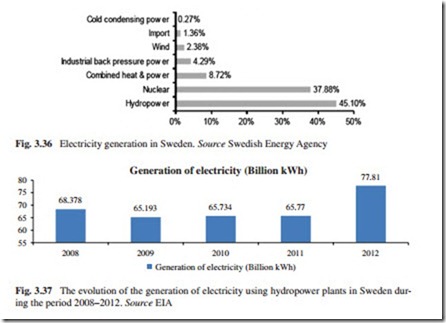Sweden
Hydropower has been a renewable source of energy, highly efficient, clean, and well developed in Sweden during the past century. Harnessed rivers provide both base-load renewable energy production and regulating power for balancing the electricity grid (i.e., maintaining the momentary balance between electricity supply and demand). On the other hand, hydropower has hydrological, ecological, and social impact that leads to a strong opposition in the country. As a result, four rivers, namely the Torne River, the Kalix River, the Pite River, and the Vindel River, have been entirely protected from harnessing by the Swedish parliament. However, the supporters of hydropower would like to expand the energy production from this source appealing to the fact that this is renewable and carbon-free energy, which is of a high importance in light of the climate change problem, and it also provides Swedish citizens and industry with relatively cheap energy and renders the opportunity for the energy producers to finance expensive projects on other renewable energy sources. The opposition thinks that since hydropower has such an impact on the environment, the goals set by the Swedish government and the Renewable Energy Directive by European parliament to increase the share of renewable energy production and fight the climate change problem could be reached without increasing hydropower in Sweden.
The Swedish environmental legislation and the Water Framework Directive on the European level also put some pressure on the hydropower sector and hinder its expansion. The environmentalists, which are the major part of the opposition, also refuse to discuss any expansion of hydropower using more streams until the requirements set by the Swedish Environmental Code will be fulfilled at every existing hydropower plant, except those plants where it can be shown that there is no need for such measures. The opposition is not against the expansion of hydropower, if it can be achieved by increasing the efficiency of the existing power plants, with- out exploiting more streams. However, the energy producers often do not dare to do this since applying for permits for this kind of changes at their existing hydropower plants they risk to lose their old permits, which last forever due to the legislation of the past. These and other concerns, such as the role of small and large hydro- power in river ecosystems, justifiability of the subsidies system called Electricity Certificate, the position of Sweden in regard to exporting renewable and regulating power to neighboring countries and the actual need for this foreign aid, problems of riparians living along the harnessed rivers, and some other issues bring active discussions among the interested parties and also in the Swedish society (Petriks 2010).
Hydropower Installed Capacity
In 2010, Sweden generated around 67,000 GWh of electricity from hydropower, making it the second biggest hydropower producer in the EU after France and the tenth biggest worldwide. In 2010, Sweden had 1,901 small hydropower plants and a total installed capacity of 1,194 MW (7.1 % of the total), generating 4,571 GWh per year.
Hydropower Electricity Generation
The participation of the hydropower sector in Sweden represents around 10 % of the total electricity generated by this type of energy source worldwide. In 2012, the country generated 77,810 GW using hydropower plants; this represents an increase of 16.1 % with respect to 2010. In 2012, the total hydropower installed capacity in Sweden reached 16,781 MW. During that year, hydropower production provides 45.10 % of Sweden’s total electricity (see Fig. 3.36). The use of hydropower plants for the generation of electricity represents 67.81 % of the total electricity generated in the country in that year using all available renewable energy sources.
Sweden’s hydropower industry is mature and with a high proportion of aging dams and plants, which are reaching the end of their life cycle. For this reason, the government has adopted a huge renovation plan in order to modernize the oldest hydropower plants. This renovation consists mainly in the replacement of turbines and generators without changes to the operating conditions of the hydro- power plants. This type of renewable energy source represents a valuable source of renewable electricity for the country and provides the capacity to balance the electricity grid.
However, it is important to highlight that the use of hydropower plants for the generation of electricity in many cases can cause ecological damage that would need mitigation measures in order to comply with Swedish and EU environmental legislation.
In the past ten years, the growth in the hydropower sector was 0.42 % per year as average and the increase was registered in six different years within that period.
The evolution of the generation of electricity using hydropower plants in Sweden during the period 2008–2012 is shown in Fig. 3.37.
The use of hydropower plants for the generation of electricity in Sweden during the period 2008–2012 increased 13.8 %. However, during the period 2008–2011, the use of this type of energy source for the generation of electricity decreased 3.9 %, but registered an important increase of 18.3 % during the period 2011– 2012. It is expected that with the renovation and modernization of the oldest hydropower plants operating in Sweden adopted by the government, the participation of the hydropower sector in the energy mix of the country will continue this trend during the coming years.
Under the government’s plan, many older small hydropower plants are now phased out of the Swedish support scheme or are undergoing large refurbishment. To be entitled to operate for the next 15 years, it is required that the plants must undergo total refurbishment of all essential parts.25 As refurbishment is very expensive and not economically viable for small hydropower plants, they are facing an uncertain future. New small hydropower development targets are few. By 2020, the aim is to have 1,960 hydropower plants with a total installed capacity of 1,230 MW (generating 5,500 GWh) (Liu et al. 2013).
